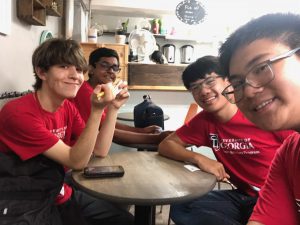Asthma is a chronic disease that affects the strength and efficiency of one’s respiratory system and can make individuals more susceptible to airborne contagions, and sometimes resulting in “asthma attacks”. An asthma attack is a sudden worsening of asthma symptoms caused by the tightening of muscles around the airways, resulting in difficulty breathing and other amplified asthma symptoms. Approximately 1 in 13 people have asthma, comprising 7.7 percent of US adults and 8.4 percent of US children, and its prevalence has been increasing since the early 1980s. According to WebMD, about three-fifths of asthma cases are believed to be hereditary due to a family history of asthma, and a person with one or both parents having asthma is three to six times more likely to develop it than someone with no asthmatic parents; other than this fact, here is no known pattern of inheritance that asthma follows. According to GeneCards, the top three genes that influence one’s asthma risk are ORMDL3 (which codes for a number of glycoproteins), ADH1C (which codes for class I alcohol dehydrogenase, which breaks down alcohol in many forms), and SPINK5 (which codes for LEKT1, a type of serine peptidase inhibitor which controls the activity of enzymes that break down other proteins). The exact reasons as to why these genes are correlated to asthma are unknown.
Asthma causes discomfort for many people, so parents may want their children tested to see if they have a susceptibility to asthma. This will allow the parents and children to better prepare and be knowledgeable on the necessary precautions and treatments for dealing with asthma. Currently there is no publicly available genetic test for asthma, as the exact genes behind it are still being identified (but several are in various stages of testing and approval, according to BioNews and Time Healthland), but a number of genes and risk factors are known, allowing doctors to more easily diagnose asthma, and let new parents know that their child may be at risk for asthma. As mentioned before, many genes are known to be correlated to asthma, but a definitive causal link has yet to be determined, so the evidence for a connection between specific variations of genes and SNPs is shaky. In addition, asthma risk can be influenced by environmental factors (such as parental alcoholism, smoking, and atmospheric pollutants), even if there is no family history of asthma.
As mentioned earlier, there is no definitive link between specific genes and asthma risk. As a result, some variations that influence one’s risk may not be identified yet, and others that have been identified may be less important than they are currently believed to be. As a result, once viable tests begin to become available, parents, children, and other individuals will have to be wary with whether they choose to get tested and which test they choose to use.
The main ethical consideration with testing for asthma is how it could potentially be used by health insurance companies against the person being tested and potentially suffering from asthma. If an individual’s health insurance company were to gain access to this information, then they could potentially deny certain coverage based on the customer’s risk for asthma. In addition, parents who know their child may be at risk for asthma could go overboard with their precautions, such as prohibiting their child from doing any sports or other activities for fear of something happening when there are actually plenty of ways for asthmatic children to safely and healthily participate in sports, which would have long-term detriments on children’s fitness and mental health.
Before getting tested for asthma, there are a few things that a family or individual should consider. First is a family history of smoking, alcoholism, and other forms of drug use or addiction. If a mother smokes or drinks alcohol during pregnancy, the child will have a heightened risk for developing asthma, and if a parent smokes during the child’s early development, there is a strong chance that this may result in the child developing asthma due to their environment rather than genes alone. In addition, if an older member of the family had or currently has asthma, there’s a strong chance that the child will too. Should the child test negative, no additional action is necessary. However, if the child tests positive, the family should look into acquiring an inhaler (preventative or reactive) for them and determine whether the child needs nebulizer treatments, in case the child does eventually develop asthma. The severity of their asthma should also be screened for. The parents should cease the use of any tobacco or other smoking-based drugs, as that would risk the child’s health. It would be advised to let a doctor know of the child’s condition.
Asthma is a serious condition, and many parents understandably want to know whether their child is at risk. Unfortunately, the only method currently available is to monitor and manage a child’s environment and conditions – if you have asthma, don’t be surprised if your child develops it too. Parents should always be prepared to care for an asthmatic child, and luckily, it’s not the worst condition a child can end up with.
Works Cited
GeneCards. ORMDL3 Gene. Retrieved from: https://www.genecards.org/cgi-bin/carddisp.pl?gene=ORMDL3
GeneCards. ADH1C Gene. Retrieved from: https://www.genecards.org/cgi-bin/carddisp.pl?gene=ADH1C
GeneCards. SPINK5 Gene. Retrieved from: https://www.genecards.org/cgi-bin/carddisp.pl?gene=SPINK5
Mayo Clinic. Asthma. Retrieved from: https://www.mayoclinic.org/diseases-conditions/asthma/symptoms-causes/syc-20369653
BioNews. (2013, January 14). Genetic test for asthma may improve treatment. Retrieved from: https://www.bionews.org.uk/page_93941
Time Healthland. (2013, June 28). Genetic Test Could Predict Which Kids Will Have Lasting Asthma Symptoms. Retrieved from: http://healthland.time.com/2013/06/28/genetic-test-could-predict-which-kids-will-have-lasting-asthma-symptoms/
WebMD. Asthma Risk Factors. Retrieved from: https://www.webmd.com/asthma/asthma-risk-factors#1



